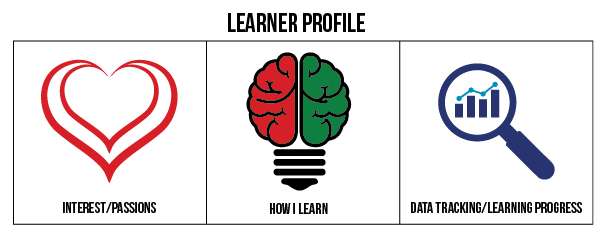Minding Our P’s and Q’s

In their book, That Used to Be Us: How America Fell Behind in the World It Invented and How We Can Come Back, Thomas Friedman and Michael Mandelbaum contend that continuous innovation is not a luxury anymore—it has become a necessity. Inspired by the need to innovate, much of our work at South View Middle School (SVMS) in Edina, MN, has centered around strategies in our own effort to improve teaching and learning through personalization. In a relatively short time, we have transformed our work to create independent learners in meaningful ways.
Three P’s
At SVMS, we have focused our work on three core components that the Institute for Personalized Learning (IPL) suggests schools incorporate as they implement personalized learning:
1. Proficiency
SVMS sponsors “sacred time” each Wednesday before school, when teams of faculty members in the same department meet to establish an aligned, guaranteed, and viable curriculum for each unit. This planning time is for departments to establish what is the essential learning for all students, to create pacing guidelines, as well as develop and analyze results from formative assessments to measure each student’s learning throughout a unit of study. Then, we build a system of personalization whereby teacher teams use the evidence of student learning to identify:
- Students who need additional time and support to gain proficiency
- Students who need enrichment and extension of their learning because they’re already highly proficient
- Teacher instructional practices and strategies to close learning gaps
Finally, we build agency and proficiency through feedback for students and staff. In the past, our traditional practice around feedback consisted of points or grades for formative work with more thorough comments given on a summative assessment. Most teachers now invest more time offering comments on the formative work and only a final score on summative work. In their article, “The Power of Feedback,” John Hattie and Helen Timperley include feedback as one of the top 10 influences on achievement. There is variability when it comes to feedback, so teachers and students need to understand which type of feedback is most effective. As Hattie has written, “Feedback should therefore be useful when it helps students navigate this gap, by addressing fundamental feedback questions including ‘Where am I going?’, ‘How am I going?’ and ‘Where to next?’” Thorough feedback in the formative process informs learners of what they know, along with an appropriate pathway for continuing their learning.
2. Pathways
We view personalized learning as a verb, an active method of best practices that puts the learner at the center of instruction. Thus, we are compelled to use a variety of strategies with multiple pathways that students can take for learning and are designed to meet the needs of all learners. Because we know from the Implementation standard (learningforward.org/standards/implementation) discussed by Julie Lambert and Valerie Mitrani, co-directors of educational services at Learning Forward, that professional learning produces changes in educator practice and student learning when implementation support is sustained over time, we designed job-embedded professional development workshops focused on building pathways for students.

We launched a system for another pathway approach last year in the form of schoolwide daily flex time. Daily flex is a time for teachers to have an instructional response to what learners need that may include an extension of learning, additional support, or reteaching of content. Implementing daily flex time involved a three-year evolution of rethinking and optimizing instructional time for efficiency. Again, based on the Implementation standard, daily flex evolved using focused, objective, relevant, valid, and purposeful feedback. (See box for our current system for schoolwide daily flex.)
All teachers offer a flex session that is a continuation of their class every day. Some learners need additional support, some need more time to process or work, and some are ready for more rigor and enrichment. A teacher may offer all three pathways in one daily flex or one pathway per day based on formative work. The result is relevant learning experiences that meet needs in real time.
3. Profiles
We ask two questions of our educators in our work to capitalize on the profiles of our students: 1) What do learners need to know about themselves? and 2) What do we need to know about each learner? We use several strategies to answer these questions for each of our students.
First, we have a daily 20-minute advisory period. Research tells us that advisory offers the chance to answer these questions because an adult adviser meets regularly during the school day with a group of students to provide academic and social-emotional mentorship and support, to create personalization within the school, and to facilitate a small peer community of learners. We ask our advisers to do academic checks each day with a few students, as well as sponsor community-building and connection opportunities for all students under their care—usually 18–22 students per adviser.
Second, we use learner profiles to help answer our guiding questions. The learner profile is each student’s “road map” to drive their growth. One page describes the student’s interests, another page highlights learning preferences, and a third page is a data collection page.

The Q’s
In our efforts to focus on student learning at SVMS, we created a guiding document, which is a shared responsibility for collaborative teams. Every Wednesday, teams spend a minimum of 45 minutes responding to one or more of these six critical questions in ways that enhance student learning:
- What do we want students to learn?
- How will we know if they have learned?
- What will we do if they don’t learn?
- What will we do if they already know it?
- What do learners need to know about themselves, and what do we need to know about each learner?
- What pathways are available for students to use for learning and demonstration of their learning?
These six critical questions are emphasized and made public to our staff and parents. We use them to guide our behavior. They have improved clarity of purpose for our staff, enhanced the focus of our work on collaboration, and informed how we allocate our resources.
Impact
We have been collecting and analyzing both quantitative and qualitative data, such as common formative and summative assessments, performance assessments, observations, and self-reports, which have all let us know that our work is having a positive impact on students, staff, families, and even other schools. Educators from over 30 schools have visited us in the last 18 months to learn about the ways in which we implement the six key questions. According to a student survey, 95% of students say they are frequently prompted to reflect on their learning, 93% report their teachers provided feedback that guided their learning choices, and 95% felt the daily flex time was beneficial to their learning.
In addition, we have conducted listening sessions to collect feedback from students. One student shared, “Flex gives you a second chance to do things you couldn’t do in class, so you aren’t missing anything.” Another student said, “At South View, you can get things done through any form you would like—in flex, at home, on our learning management system—it makes it more helpful so you can learn better.”
Staff, too, have overwhelmingly reported positive results. For example, 91.7% say students can explain what they are learning, 87.9% say students feel challenged, 94.4% report students’ challenges and strengths are known, and 93% say daily flex had a significant positive impact on student learning.
The Right Conditions
Today, schools need leaders of learning who can create the right conditions for implementation of new ideas. We believe that fostering learning communities focused on creating proficiency, profiles, and pathways for students, and the adults who serve them, is a promising way to do this. Indeed, we are excited about the future-ready impact this approach is having on our learners and our community.
Tim Anderson, EdD, is the principal of South View Middle School in Edina, MN. Ryan Carlson is a principal of Wayzata West Middle School in Wayzata, MN. TamiJo Cook, EdD, is the dean of students at South View Middle School. Kaela Loo and Patricia Pettis are instructional coaches, teachers, and bloggers at South View Middle School.
